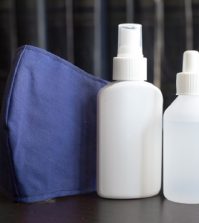- Study Says Most Parents Don’t Use Car Seats In Ride Share Vehicles Like Uber
- This 12-Year-Old Boy Is A Sophomore Aerospace Engineering Major!
- Fire Safety Experts Warn Of Hand Sanitizer Danger After A Mom and Kids Escape House Fire
- Recall Alert: Peaches May Be The Cause Of Salmonella Outbreak, 68 People Ill
- Summer Vacation In The Days Of COVID: Tips To Stay Safe
- How To Safely Grocery Shop During The Coronavirus Pandemic
- Michigan Teen With Vape-Related Illness Undergoes Double Lung Transplant
- Teen Kicks Off Anti-Vaping Campaign From Hospital Bed
- Teenager Receives Life Sentence For Strangling Sister To Death Over A Wi-Fi Password
- Toddler Falls To Death From 11th Deck of Cruise Ship
The Unsafe Way Parents Are Using Their DockATots


This stylish, relatively new baby gear product is lusted after by many new Mothers.
The DockATot has more than 280,000 Instagram followers, plenty of devoted mom bloggers have it plugged in their feeds, and celebrities like Kim Kardashian are huge fans.
The DockATot came to Canada in the spring of 2016 and is now available in two sizes. (The smaller “deluxe” size for babies under nine months will cost you about $270 new and the “grand” size runs about $470.)
However, parents who are considering adding the increasingly popular cushioned baby lounger—or another similar product— to their baby registries should be aware that using it as a place for infants to sleep may be dangerous.
Health Canada released an advisory last week, warning parents that letting babies sleep in baby nests, or “baby pods,” puts them at risk of suffocating. They define a baby nest as any portable infant bed with soft padded sides.
“We are aware of open investigations in another jurisdiction regarding baby nest incidents,” says Gary Holub, spokesperson for Health Canada.
He adds that “there have not been any incidents involving baby nests reported to Health Canada.”
Health Canada’s statement warns parents and caregivers against leaving babies unattended in those products (this includes letting babies sleep in them while a parent sleeps nearby), putting the nest inside a playpen or crib for sleep, or using the product as a co-sleeper in a parents’ bed.
Putting a baby nest product on soft surfaces such as mattresses or couches increases the risk of suffocation.
The DockATot’s website is clear that the Deluxe version, which is made for babies up to the age of nine months, isn’t for unsupervised sleep or nighttime sleep. (Safe sleep rules—such as keeping pillows and blankets out of the crib—are much more relaxed for babies and toddlers over 12 months of age.)
Despite this warning, many parents are using it that way. Its online reviews contain comments like “my newborn baby loves it and sleeps 5-6 hrs straight in it!” and “ridiculously expensive but worth it… it’s the safest way to co-sleep.”
Unfortunately, this is not true. “There’s no question that the DockATot isn’t a safe sleep device,” says Denis Leduc, a community-based pediatrician and clinical director of the newborn nursery at Montreal’s Royal Victoria Hospital. “On the contrary, a baby can easily obstruct its airway by turning towards one of those elevated sides. This is not anything that I would be comfortable recommending to parents.”
The company’s website also says the DockATot is “100 percent breathable.” But that isn’t reassuring to Lori Feldman-Winter, a pediatrician in Camden, New Jersey, and a member of the American Academy of Pediatrics’ Task Force on Sudden Infant Death Syndrome.
Feldman-Winter says that the products claiming to be breathable haven’t been proven to reduce the risk of SIDS. “That’s why we don’t recommend any bumpers or mattress pads, even those that are marketed as breathable,” she explains.
Health Canada’s guidelines for safe sleep advise that all babies under a year old are put to sleep on their backs, in a crib or bassinet, with nothing else in it whatsoever.
This guideline includes any kind of pillows, loose blankets, sleep positioners or foam padding. The American Academy of Pediatrics agrees: “When we talk about infants, we don’t recommend anything that would be analogous to a pillow, or a bumper, or a soft surface,” says Feldman-Winter. “This might be nice while the baby is awake and playing, as a cushion, but [the need for] observation is the key here.”
For parents who are desperate for a few more minutes of sleep, she says a sidecar co-sleeper—a three-sided bassinet that attaches to the side of the parents’ bed—is a safer choice, but not the safest choice. (While co-sleeper sidecar bassinets are available to buy in the US, three-sided styles are not recommended by Health Canada, and some sidecar bassinet products have been discontinued in Canada.)
Leduc agrees. “The first thing we recommend is baby sleeping in his own crib or bassinet next to the parents’ bed, but if that seems to be something that the parents can’t handle, [a sidecar sleeper] is something we could agree to, as a compromise,” he says. “It’s a reasonable alternative.”
Elina Furman, director of marketing at DockATot, advises that her company’s product isn’t intended to be used for baby sleep. “The DockATot is used by many for supervised lounging, chilling and play time,” she says. “We subscribe to Health Canada’s guidelines for the promotion of our products to Canadians. We do not promote our products to Canadians as intended for sleep accommodation.”









0 comments